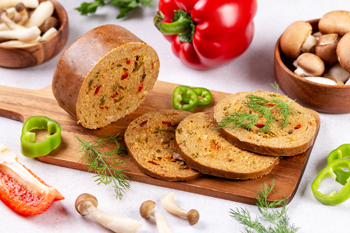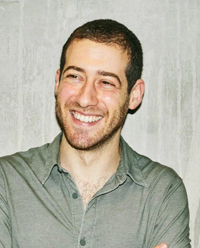Meat free meat with maths
Veganism, vegetarianism, and flexitarianism have been booming. There are three main reasons for people turning away from meat and dairy: concerns about their own health, about the environmental impact of the meat and dairy industries, and about animal cruelty.
However, while studies in 2020 suggested that the number of people who consume plant-based alternatives had roughly doubled over the previous ten years, recent reports suggest that sales in the UK have since stagnated. The cost of living crisis may have something to do with this — plant-based alternatives tend to be expensive — but perhaps it's also to do with flavour. If you like meat, then vegan burgers and sausages may not cut it.

If you like your meat then plant based alternatives may not cut it.
This is where mathematician Ed Steele and his biologist friend Max Jamilly have spotted an opportunity. Their company Hoxton Farms is developing processes for growing stem cells from pigs into fat cells. The resulting fat can then be used as an ingredient in food, alongside plant proteins.
"We recognised that the traditional meat industry is broken," says Steele. "It's killing us and it's killing the planet. [At the same time] we saw the demand for meat alternatives soar. But we think that plant-based meat still isn't good enough yet. And that's because it's missing this one key ingredient: fat. Fat is what gives meat its flavour. If you cook it in the right way it gives you all the magic that you need for a really meaty dish."
The result won't be a vegan or vegetarian product, of course, it'll be animal-derived. "But it's made without harming animals and avoids the environmental damage of traditional animal agriculture," says Steele. "It ticks the boxes that [many] people are looking for in meat alternatives. We call the ingredient we make 'cultivated fat'."
Hoxton Farms is still in the research and development phase, with a team of 35 working in a lab in London on optimising the process and scaling it up. But a larger manufacturing facility is planned for the next couple of years, and Steele thinks that their product may be commercially available within a few years.
What gives Hoxton Farms the edge over competitors working on similar processes, Steele thinks, is that mathematics plays a central role in all that is involved: from feeding the stem cells to optimising the bioreactor they grow in. "We have this awesome way of working internally, where mathematicians and statisticians work very closely with biologists. It's one of the ways we think we have a superpower as a company: the interdisciplinary nature of all the work that we do."
Feeding cells
An important aspect of growing stem cells is to find the cells' favourite food. The cells are fed growth media, which can be made up of a large number of components. "The media [are] the most expensive part of the process of growing cells at large scale," says Steele.

Ed Steele is co-founder of Hoxton Farms.
Feeding the cells the optimal growth media is vital, but the number of possible recipes is so large that finding the best ones through experimentation is impossible. Biological theory doesn't help either. "It's relatively difficult to build a biological understanding of how the different media components will interact with each other and interact with the cells."
Here Hoxton Farms uses the help of machine learning, whose powerful ability to spot patterns in data has been all over the news lately. You can think of the collection of all possible growth media recipes as a landscape, with the optimal ones dotted throughout. The people at Hoxton Farms explore a small patch of this landscape experimentally, feeding the recipes to the stem cells and watching how they grow into fat cells. The resulting data about their growth is then fed to a machine learning algorithm which, based on this information, suggests which part of the landscape might be good to explore next. The corresponding recipes are tried out on the stem cells, the data is again fed to the algorithm, which again makes optimal use of the information to suggest a new patch to explore. Combined with the expertise of human biologists, this feedback approach (technically known as Bayesian optimisation) guides the way through the recipe landscape to find those that perform best.
"[This approach] completely changes the way we think about media optimisation," says Steele. "Being able to use a modelling approach, rather than a guess work or a biological approach, means we can move much faster and end up with solutions that are much better."
Seeing cells
Carefully monitoring the development of the cells is obviously crucial. "One of the main ways we get information about our cells is by taking lots of images using microscopes and then analysing those images," says Steele. There are many pieces of information to record from a single image: how many cells there are, what their shape is, and how large fat droplets are inside them, for example. If you have ever looked through a microscope at a bunch of cells, you can imagine that this is a painstaking, time-consuming task for a human.
Hoxton Farms is currently hiring software engineers and modelling engineers! Find out more here.
Again it's machine learning that helps. By training machine learning algorithms to recognise important features in an image of cells, mathematicians at Hoxton Farms have built a bespoke computer vision tool that can do much of the work for the team. "The [tool works] really well, much better than the scientists would themselves," says Steele.
Stirring cells
The whole process of stem cells growing into fat cells happens in a bioreactor, a big tank, which has the cells suspended in the growth media, which is a liquid. "The tank has an impeller which spins around to mix everything together. Oxygen bubbles through the bottom of the tank. Everything needs to be well mixed so that all of the cells get oxygen and different [components] of the media. You don't want pockets where certain waste products or media components build up."

Pigs will be spared if cultivated fat becomes the norm.
There are many different ways of setting up the tank with its impeller to mix things around, and again it's important to find the optimum. Rather than using trial and error experimentation, Hoxton Farms use computational fluid dynamics. Based on the equations that describe the flow of liquids, this approach uses computers to simulate its behaviour in different settings.
"Then we can change things, for example we can see what happens if we change the rate of the impeller, or the head of impeller, or push oxygen through the [tank] in a slightly different way. Computational fluid dynamics is an important tool for us to model [what happens in the bioreactor]."
These are just some examples of how a mathematical approach can help with the work that is being done at Hoxton Farms. The fact that the team includes mathematicians and statisticians alongside biologists, rather than only biologists with maths and stats training, is vital, Steele thinks. "We are constantly thinking about how we can use people on the team with different skill sets, in particular on the mathematical modelling side and the statistics side, to make a difference to the work we do."
Is it safe?
Once the manufacturing process is optimised, the next step will then be to have the product approved by regulators. "We need to demonstrate to the regulators that the process we use to grow the fat cells results in a product that is safe to eat. We are very confident that this is the case and that it is significantly safer than meat produced using traditional animal agriculture. The environment we work in is sterile, and that's through necessity. The cells we work with have no immune system so they have to grow in an extremely clean environment. A slaughter house is a completely different environment." Steele also points out that the antibiotics used in traditional meat production to deal with diseases are not needed in a sterile environment.
"On the safety side we [have no concerns] and on the health and nutritional side what we do gives you the same as if you were to eat traditional pork fat."
Maths and taxes
When we initially contacted Ed Steele it wasn't only because we were interested in meat alternatives, but also because we were on the look-out for companies that make use of a feature of UK taxation that perhaps isn't as well-known as it should be: research and development (R&D) in mathematics qualifies for tax relief, just as R&D in other subjects does.

The process that is being developed at Hoxton Farms can also be used to grow fat cells out of stem cells from cows, other mammals, and even fish.
For Hoxton Farms mathematical tax relief has been extremely useful. "It is hugely important; every year we submit an R&D tax credit claim," says Steele. "It's one of the amazing things about doing research in the UK and has been a huge help."
And although the UK government has recently slightly reduced the amount of R&D tax credits available, it has widened the scope on another front: as of April 2023 pure mathematics also counts as part of science for the purposes of R&D tax relief. This means that companies wanting to claim tax relief for R&D can now do so even if the R&D involves pure maths with no obvious, direct applications."As a mathematician I [completely agree with this]," says Steele. "[For example] basic research in biology has always counted as something you can claim R&D tax credits for, even though when you are doing basic research you are not trying to find out something in particular, you're just trying to learn about [biological] systems. I don't see why there would ever be a difference between pure maths research and basic research in biology. The maths that we use, while it is very applied, of course is built from pure maths. Unless you have the research going on in pure maths you will miss out on the future benefits in the applied fields."
Exactly when cultivated fat will appear routinely on the food labels we study in the supermarket isn't clear yet, but Steele thinks it will be a matter of a few years, rather than decades. Pork fat isn't the only animal fat that can be produced in this way. Beef and other mammalian fats, and even fish fat, are also options. Perhaps we will one day see an end to the cruelty and environmental damage that comes with the meat industry and fisheries. And if we do, then this will be in some small part down to mathematics.
About this article
Marianne Freiberger, Editor of Plus,interviewed Ed Steele in July 2023.
This article was produced as part of our collaboration with the Isaac Newton Institute for Mathematical Sciences (INI) – you can find all the content from the collaboration here.
The INI is an international research centre and our neighbour here on the University of Cambridge's maths campus. It attracts leading mathematical scientists from all over the world, and is open to all. Visit www.newton.ac.uk to find out more.
